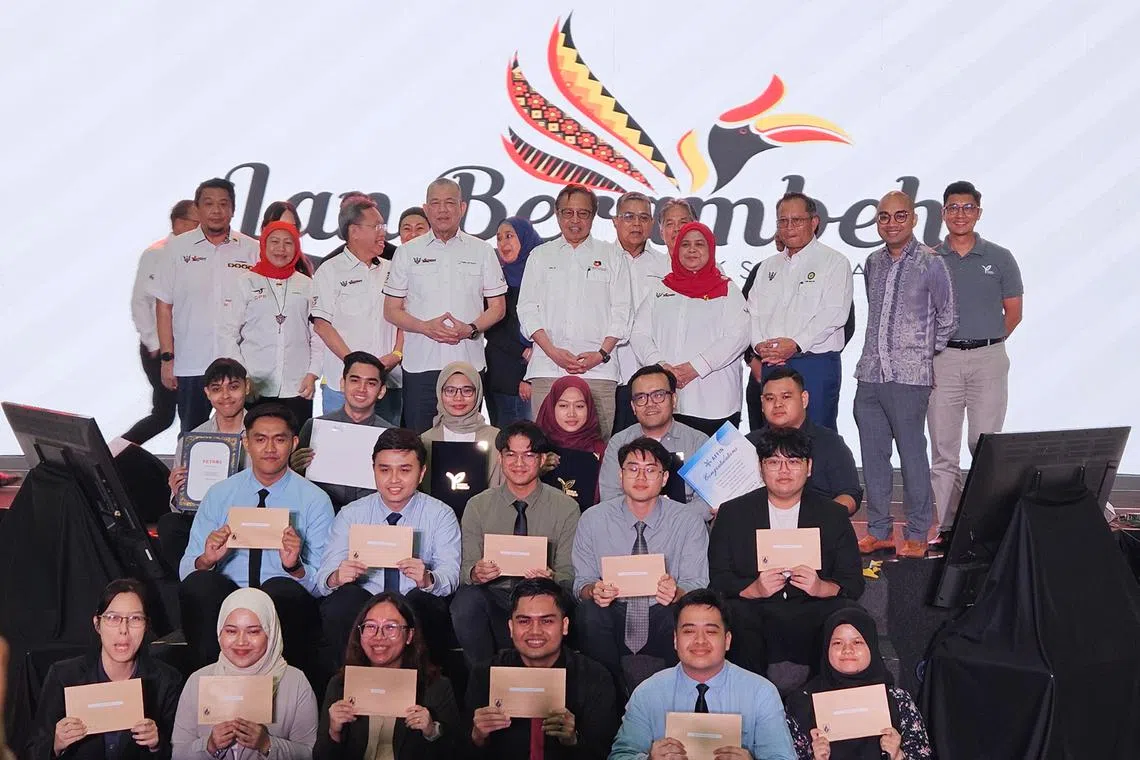Malaysia’s Sarawak state aims to be regional green energy powerhouse, boost talent pool
Sign up now: Get ST's newsletters delivered to your inbox

Sarawak premier Abang Johari Openg witnesses the industrial placement offer letters to 34 students by Petronas, Sarawak oil company Petros and Affin Bank in Kuala Lumpur.
ST PHOTO: LU WEI HOONG
Follow topic:
KUALA LUMPUR – Malaysia’s Sarawak state aims to become a regional renewable-energy “powerhouse” over the next decade and is persuading its skilled workforce to return home to help achieve this ambition.
As such, the state government is offering to make green technology courses, such as hydrogen production and carbon storage, free for locals at state tertiary education institutions, starting in 2026.
“Sarawak will be the powerhouse of Asean. We will connect our renewable energy-sourced power grid to Asean
He was speaking at a town hall session attended by about 1,000 Sarawak students at the 15th annual Lan Berambeh Anak Sarawak (Sarawakian diaspora gathering) in Kuala Lumpur.
The plan dovetails with the Borneo state’s ambition to produce 15,000MW of green energy annually by 2035 for domestic and overseas use. Sarawak’s electricity output was 5,745MW in 2023.
But the East Malaysian state acknowledged that it is short of 300,000 skilled workers needed to meet the required 500,000 by 2030, in particular microelectronics and maritime experts to develop the renewable energy industry. The maritime experts are needed as Sarawak plans to ship its hydrogen by sea to Japan.
Sarawak – Malaysia’s largest state by land area – has been given more autonomy since 2008 to chart its own political and economic destiny, as allowed under the 1963 Malaysia Agreement (MA63) that led to the formation of Malaysia.
With a population of just 2.5 million – of the total 33 million residents in Malaysia – Sarawak today has its own development bank, petroleum company, and state media organisation. The title of the state’s chief executive, previously called chief minister, was changed in March 2022 to premier.
Currently, Sarawak’s power is generated mainly from hydroelectric plants from the Bakun, Murum and Batang Ai dams, with coal and gas as secondary sources of supply. The state says that 62 per cent of its energy generation so far in 2024 has been derived from renewable energy sources, already surpassing its target of 60 per cent by 2030.
The Sarawak state government is working with South Korea’s Samsung Engineering, Lotte Chemical and Posco to build a green hydrogen production plant with an annual capacity of 150,000 tonnes, and a green ammonia conversion plant with an annual capacity of 850,000 tonnes in Bintulu. Both plants are expected to be operational in 2028. Green hydrogen is hydrogen produced by splitting water via electrolysis, which results in much lower greenhouse gas emissions than production of grey hydrogen that is derived from fossil fuels without carbon capture.
Japan’s energy company Eneos and trading house Sumitomo Corp will be building a plant in Bintulu with the Sarawak state government. The plan is to produce 90,000 tonnes of green hydrogen in 2030 with most of the output meant for the Japanese market.
To raise the required number of skilled workers for the state’s renewable energy sector, Sarawak’s federal lawmaker Doris Sophia Brodi has urged its diaspora to return home.
“There are currently 52,000 Sarawak intellectuals and talents spread across Peninsular Malaysia, Singapore and Australia. Our government is building a new platform for you,” she said in a speech at the town hall meeting. “When you finish your studies, please come back. We experienced a brain drain, but we need to achieve a brain gain by 2030.”
The free, green-tech courses being offered to Sarawakians from 2026, ranging from diploma to post-graduate levels, will likely be taught at institutions of higher learning in the state such as University of Technology Sarawak and Kolej Laila Taib, as well as the local campuses of Australia’s Swinburne University of Technology and Curtin University.
“The free education is for selected courses, such as engineering and technical disciplines, to meet the state’s requirements. We acknowledge that we must fast-track our efforts to address the talent shortage,” Malaysia’s Deputy Prime Minister Fadillah Yusof told The Straits Times. Datuk Seri Fadillah is from Sarawak.
Mr Mohd Azizul Hafeez, a welding-technology undergraduate at Universiti Tun Hussein Onn in Johor, hopes to secure a brief industrial placement in Peninsular Malaysia in 2025 before returning to his home state to work.
“I will gain experience for a while, maybe one or two years, in a peninsular corporation. Welding is very crucial for maintaining pipes in the oil-and-gas sector,” the 23-year-old Miri native said.
Still, for Malaysians from the peninsula or Sabah state, who want to work in the Land of the Hornbills, there is an added barrier: Along with foreigners, these non-Sarawakians must first apply for an employment pass.
The Sarawak government should consider easing up on this rule to attract talent from outside the state, said Mr Lee Heng Guie, executive director of the Socio-Economic Research Centre.
“Overall, Peninsular Malaysians face challenges in Sarawak due to (such) protectionism. While nurturing and upskilling local talent is crucial, allowing talent from Peninsular Malaysia (and Sabah) to work in Sarawak is equally important,” he told ST.
Mr Lee suggested that Sarawak could tap the regular stream of foreigners studying in the state by offering them employment in critical sectors such as renewable energy.
Indeed, since 2022, Sarawak has eased its regulations for professionals and technical experts in the energy and digital industries, allowing them to obtain work visas for up to five years.


